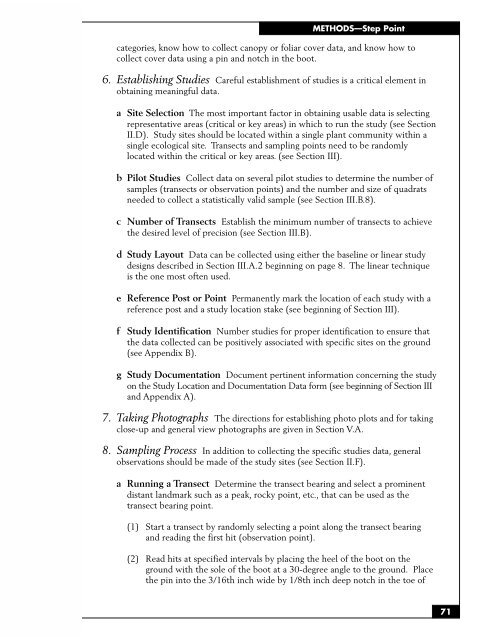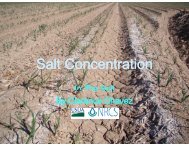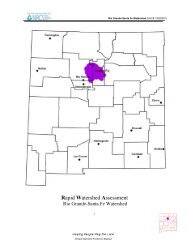SAMPLING VEGETATION ATTRIBUTES - New Mexico NRCS - US ...
SAMPLING VEGETATION ATTRIBUTES - New Mexico NRCS - US ...
SAMPLING VEGETATION ATTRIBUTES - New Mexico NRCS - US ...
You also want an ePaper? Increase the reach of your titles
YUMPU automatically turns print PDFs into web optimized ePapers that Google loves.
METHODS—Step Point<br />
categories, know how to collect canopy or foliar cover data, and know how to<br />
collect cover data using a pin and notch in the boot.<br />
6. Establishing Studies Careful establishment of studies is a critical element in<br />
obtaining meaningful data.<br />
a Site Selection The most important factor in obtaining usable data is selecting<br />
representative areas (critical or key areas) in which to run the study (see Section<br />
II.D). Study sites should be located within a single plant community within a<br />
single ecological site. Transects and sampling points need to be randomly<br />
located within the critical or key areas. (see Section III).<br />
b Pilot Studies Collect data on several pilot studies to determine the number of<br />
samples (transects or observation points) and the number and size of quadrats<br />
needed to collect a statistically valid sample (see Section III.B.8).<br />
c Number of Transects Establish the minimum number of transects to achieve<br />
the desired level of precision (see Section III.B).<br />
d Study Layout Data can be collected using either the baseline or linear study<br />
designs described in Section III.A.2 beginning on page 8. The linear technique<br />
is the one most often used.<br />
e Reference Post or Point Permanently mark the location of each study with a<br />
reference post and a study location stake (see beginning of Section III).<br />
f Study Identification Number studies for proper identification to ensure that<br />
the data collected can be positively associated with specific sites on the ground<br />
(see Appendix B).<br />
g Study Documentation Document pertinent information concerning the study<br />
on the Study Location and Documentation Data form (see beginning of Section III<br />
and Appendix A).<br />
7. Taking Photographs The directions for establishing photo plots and for taking<br />
close-up and general view photographs are given in Section V.A.<br />
8. Sampling Process In addition to collecting the specific studies data, general<br />
observations should be made of the study sites (see Section II.F).<br />
a Running a Transect Determine the transect bearing and select a prominent<br />
distant landmark such as a peak, rocky point, etc., that can be used as the<br />
transect bearing point.<br />
(1) Start a transect by randomly selecting a point along the transect bearing<br />
and reading the first hit (observation point).<br />
(2) Read hits at specified intervals by placing the heel of the boot on the<br />
ground with the sole of the boot at a 30-degree angle to the ground. Place<br />
the pin into the 3/16th inch wide by 1/8th inch deep notch in the toe of<br />
71




